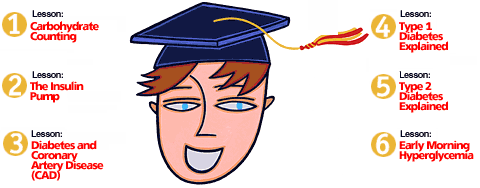



 |
|
|

|
|
Diabetes Lesson 2 - The Insulin Pump 
An insulin pump is a wallet -sized machine that is usually worn on a belt or in a pocket. With the help of a computer chip inside, the pump continuously dispenses predetermined amounts of insulin to the patient through a plastic tube (known as a cannula) attached to a needle or plastic rod inserted underneath the skin. This method of insulin delivery is known as continuous subcutaneous insulin infusion (CSII). The ideal area for insertion is into the abdominal wall (which has the highest and most consistent rate of insulin absorption on the body) or directly into a vein on the arm or thigh. These pumps use either lispro or phosphate-buffered insulin, which are less likely to clog the pump. Weighing usually less than four ounces, the pump is designed to dispense insulin in two different delivery patterns--via (1) the Basal dose and (2) the Bolus dose.
The average daily Basal dose is usually between 40 to 50 percent of your total daily insulin dose, while the Bolus doses constitute the remaining 50 to 60 percent. Your physician should help you calculate target Basal and Bolus doses before using the pump. The main purpose of the pump is to provide patients with perfectly measured insulin doses on a predetermined schedule, eliminating the inconvenience, hassle, or, as some feel, embarrassment associated with taking insulin injections throughout the day. To get a better idea of how an insulin pump does its job, click here for a short instructional video entitled "Peek at the Pump." Page 1 2 3 4 5 Copyright © 2000-2025 savvyHEALTH.com. All rights reserved.
|
|
|
|||||||||||||||||
|
About savvyHEALTH | Privacy | Feedback | Home
http://www.savvyHEALTH.com/
All contents copyright © 1999-2025 savvyHEALTH, Inc. All rights reserved.
This internet site provides information of a general nature and is
designed for educational purposes only. If you have any concerns about
your own health, you should always consult
with a physician or other healthcare professional. Please review the Terms of Use before using this site. Your use of the site indicates your agreement to be bound by the Terms of Use.
|
|